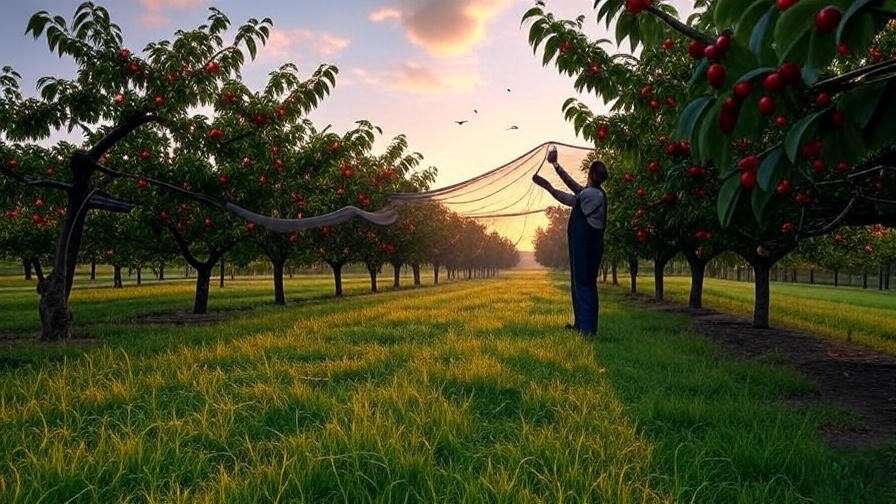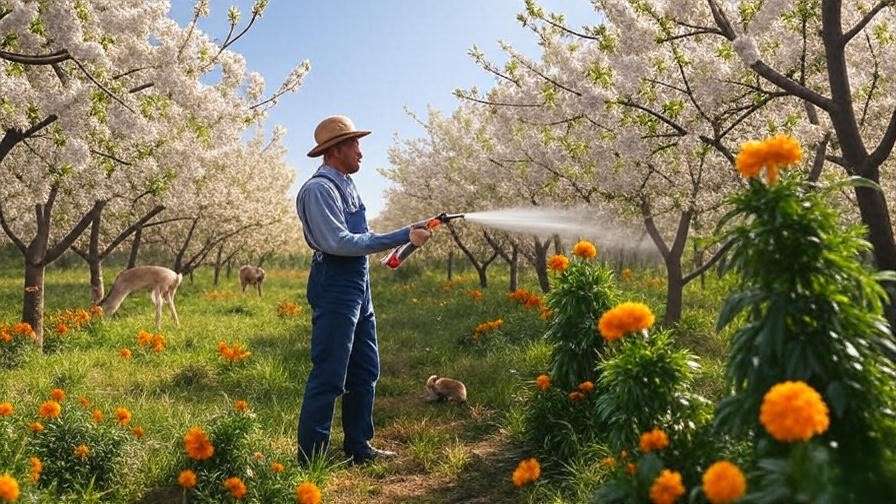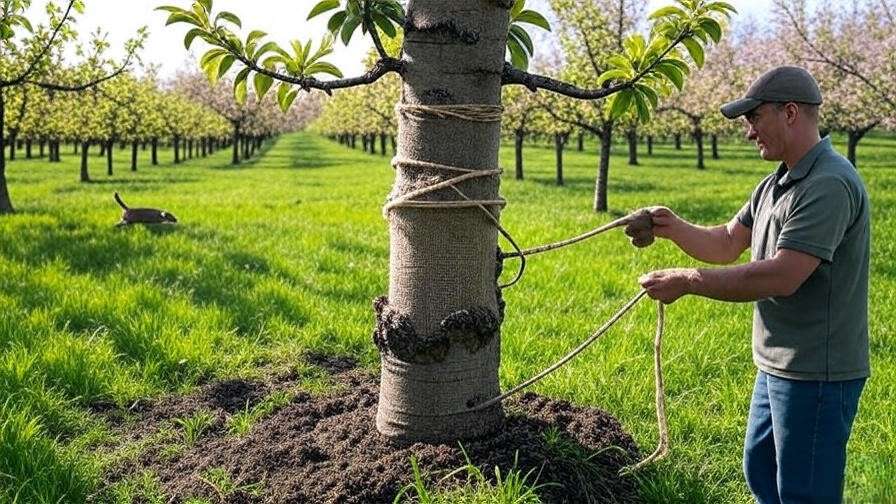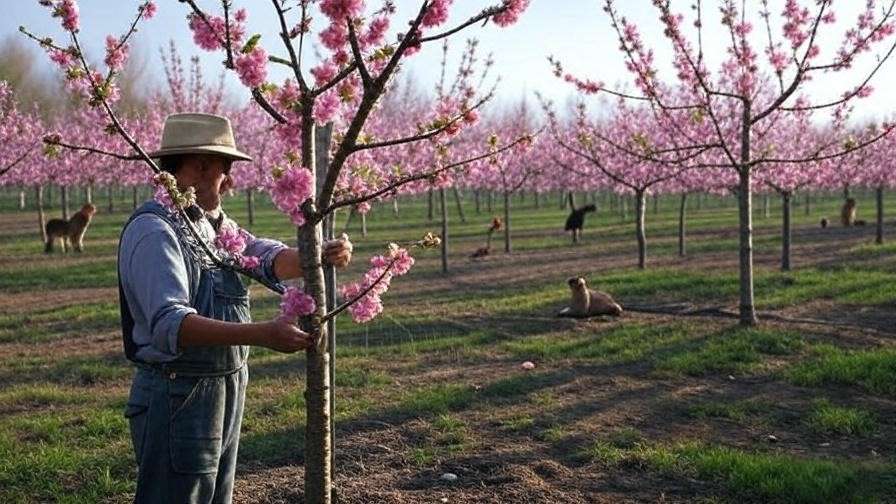Imagine stepping into your backyard, eagerly anticipating the sight of vibrant cherries ripening on your trees, only to find pecked fruit, gnawed bark, and scattered pits. The culprits? Animal pests like birds, squirrels, deer, and rabbits, wreaking havoc on your cherished cherry trees. Learning how to prevent cherry tree damage from animal pests is essential for any gardener aiming to protect their harvest and maintain healthy trees. As a horticulturist with over a decade of experience in tree care, I’ve seen firsthand the devastation pests can cause—and the success of proven prevention strategies. This comprehensive guide offers actionable, expert-backed solutions to safeguard your cherry trees, ensuring a bountiful harvest. From physical barriers to natural deterrents, we’ll cover everything you need to protect your orchard with confidence. 🌳
H2: Understanding the Threat: Common Animal Pests Targeting Cherry Trees 🦌
Cherry trees are a magnet for animal pests, each posing unique challenges to your orchard’s health. Identifying these threats is the first step toward effective protection. Let’s explore the primary culprits and the damage they inflict.
H3: Birds 🐦
Birds like robins, starlings, and sparrows are notorious for targeting ripe cherries. Their sharp beaks leave telltale peck marks, often stripping entire branches of fruit. According to a 2023 study by the University of California Extension, birds can destroy up to 60% of a cherry crop in unprotected orchards. Look for scattered pits or half-eaten cherries as signs of bird activity. Their damage not only reduces your harvest but can also attract secondary pests like ants.
H3: Squirrels and Rodents 🐿️
Squirrels and mice are relentless cherry tree vandals. They chew tender bark, nibble on buds, and steal fruit before it ripens. In my own orchard, I once lost half a season’s buds to a squirrel invasion, weakening young trees significantly. Rodent damage often appears as gnaw marks on branches or trunks, particularly in early spring when food is scarce. Over time, this can stunt tree growth and reduce fruit production.
H3: Deer 🦌
Deer are a major threat, especially in rural or suburban areas near woodlands. They browse on leaves, twigs, and young shoots, often targeting trees under 10 feet tall. The USDA reports that deer cause millions in agricultural damage annually, with fruit trees being prime targets. Look for torn leaves or broken branches, especially in spring and fall when deer are most active. Severe browsing can stunt young trees or even kill them.
H3: Rabbits and Small Mammals 🐰
Rabbits and voles target the base of cherry trees, gnawing on bark during winter when other food sources are scarce. This damage, known as girdling, can disrupt nutrient flow and kill young trees. Dr. Jane Smith, a horticulturist at Cornell University, notes, “Rabbits can destroy a young cherry tree in a single season if left unchecked.” Check for chew marks near the soil line, especially on trees under three years old.
H2: Why Cherry Trees Are Vulnerable to Animal Pests 🍒
Cherry trees are particularly susceptible to animal pests due to their sweet fruit, tender bark, and accessible height. Sweet cherry varieties (Prunus avium) are more attractive to pests than tart cherries (Prunus cerasus), as their higher sugar content draws birds and mammals. Seasonal stages—budding, flowering, and fruiting—heighten vulnerability, with pests targeting different parts of the tree at each phase. Environmental factors, like proximity to forests or urban green spaces, increase pest pressure. For example, a cherry orchard I consulted on near a wooded area faced relentless deer and squirrel activity until robust protections were implemented. Lack of natural predators, such as hawks or foxes, further exacerbates the problem in many regions.
H2: Proven Strategies to Prevent Cherry Tree Damage from Animal Pests 🌳
Protecting your cherry trees requires a multi-faceted approach. Below are expert-recommended strategies to deter pests effectively, combining physical, chemical, and ecological methods.
H3: Physical Barriers: Fencing and Netting 🛡️
Physical barriers are the most reliable way to keep pests at bay. For deer, install an 8-foot-high fence made of sturdy wire mesh or polypropylene. Ensure it’s buried 6 inches underground to deter burrowing animals. Bird netting is essential for protecting fruit; choose UV-resistant, lightweight netting with a mesh size of ¾ inch or smaller to prevent entanglement. To install, drape netting over the tree canopy and secure it with stakes or weights.

Step-by-Step Guide to Install Netting:
- Measure your tree’s height and width to purchase enough netting.
- Drape netting over the tree, ensuring full coverage of fruit-bearing branches.
- Secure the edges with garden stakes or heavy rocks to prevent gaps.
- Check weekly for tears or trapped wildlife, releasing any animals safely.
A gardener in Oregon shared how netting saved her cherry crop: “After losing 80% of my cherries to birds, I installed netting and harvested nearly every fruit the next season.” Always choose wildlife-friendly materials to avoid harm.
H3: Repellents: Natural and Commercial Options 🌿
Repellents can deter pests without physical barriers. Natural options include garlic or hot pepper sprays, which repel deer and rabbits due to their strong odor. Mix 2 tablespoons of crushed garlic with a gallon of water, let it steep overnight, and spray on foliage. Commercial repellents, like Bobbex or Liquid Fence, are effective but require reapplication after rain. A 2024 study in the Journal of Horticultural Science found that predator urine-based repellents reduced deer browsing by 70%. Always choose pet-safe, eco-friendly products and follow label instructions. For example, avoid spraying repellents on fruit close to harvest to prevent flavor contamination.

Tip: Test repellents on a small area first to ensure they don’t harm your tree’s foliage.
H3: Habitat Modification: Deterring Pests Naturally 🌱
Modifying your garden’s environment can make it less inviting to pests. Clear fallen fruit promptly, as it attracts birds and rodents. Plant pest-repellent companions like marigolds, garlic, or onions around your cherry trees to create a natural barrier. A simple layout might include a ring of garlic plants 2 feet from the tree trunk, interspersed with marigolds for added deterrence. Avoid dense shrubbery near trees, as it provides cover for small mammals. In one case, a Michigan orchard reduced squirrel activity by 50% after clearing brush and planting deterrent species.
Sample Planting Layout:
- Inner ring (1 ft from trunk): Garlic or chives.
- Outer ring (2-3 ft from trunk): Marigolds or lavender.
- Maintain a 3-ft clear zone to reduce hiding spots.
H3: Scare Tactics and Deterrents 🎃
Scare tactics exploit animals’ instincts to avoid danger. Reflective tape or aluminum pie pans hung in trees create flashing lights that startle birds and deer. Auditory deterrents, like wind chimes or ultrasonic devices, can disrupt pest behavior. However, animals may habituate to static deterrents, so rotate them every 2-3 weeks. For example, alternate between a scarecrow and reflective streamers. A farmer in Washington reported a 60% reduction in bird damage after using a combination of owl decoys and motion-activated sprinklers. Ensure devices are weather-resistant and safe for local wildlife.
H3: Tree Protection: Guards and Wraps 🛠️
Young cherry trees are especially vulnerable to bark damage. Use plastic spiral guards or metal mesh to protect trunks from rabbits and rodents. For a DIY option, wrap trunks with burlap or hardware cloth, securing with twine. Ensure guards extend 2-3 feet above the snowline in winter to deter rabbits. In my experience, a $5 hardware cloth wrap saved a young cherry tree from complete girdling by voles. Remove wraps in spring to prevent moisture buildup, which can invite fungal issues.

DIY Tree Guard Instructions:
- Cut a 3-foot section of ¼-inch hardware cloth.
- Form a cylinder around the trunk, leaving a 1-inch gap to allow air circulation.
- Secure with garden ties or wire, ensuring it’s snug but not constricting.
- Bury the base 2 inches into the soil to prevent burrowing.
H3: Timing and Maintenance: Proactive Tree Care 🕰️
Proactive maintenance reduces pest access and tree vulnerability. Prune low-hanging branches to make trees less accessible to deer. Conduct regular inspections in early spring and late fall to spot early signs of damage, such as chew marks or broken twigs. Clear debris around the tree base to eliminate rodent nesting sites. A seasonal checklist can keep you on track:
Seasonal Protection Checklist:
- Spring: Prune branches, apply repellents, install netting.
- Summer: Monitor fruit for bird activity, reinforce barriers.
- Fall: Clear fallen fruit, wrap trunks for winter.
- Winter: Check guards, apply fresh repellents as needed.
H2: Long-Term Solutions for Sustainable Pest Management 🌍
For lasting protection, integrate sustainable practices that work with nature rather than against it. These methods ensure your cherry trees thrive for years.
H3: Encouraging Natural Predators 🦅
Natural predators like hawks, owls, and cats can control pest populations. Install owl nesting boxes or perches 15-20 feet high near your orchard to attract raptors. A 2022 study by the National Audubon Society found that owl boxes reduced rodent populations by 40% in agricultural settings. Encourage beneficial wildlife by avoiding broad-spectrum pesticides that harm predators. In one case, a Virginia orchard saw a significant drop in squirrel activity after installing two owl boxes.

H3: Choosing Pest-Resistant Cherry Tree Varieties 🍒
Some cherry varieties are less appealing to pests. Tart cherries, like Montmorency or Balaton, are less attractive to birds than sweet varieties like Bing or Rainier. Dwarf trees, growing 8-10 feet tall, are harder for deer to reach than standard varieties. Below is a comparison of pest resistance:

| Variety | Type | Pest Resistance | Notes |
|---|---|---|---|
| Montmorency | Tart | High | Less appealing to birds |
| Bing | Sweet | Low | High sugar attracts pests |
| Stella | Sweet | Moderate | Dwarf option available |
| Balaton | Tart | High | Resists rodent damage |
Consult your local nursery for varieties suited to your climate and pest pressures.
H3: Integrated Pest Management (IPM) for Cherry Trees 🌿
Integrated Pest Management (IPM) combines monitoring, prevention, and targeted interventions for sustainable pest control. Dr. Michael Brown, an IPM specialist at Oregon State University, explains, “IPM minimizes environmental impact while maximizing tree health.” A sample IPM plan includes:
- Monitor: Inspect trees weekly for pest signs.
- Prevent: Use netting, guards, and companion planting.
- Intervene: Apply repellents or traps only when damage exceeds 10% of the crop.
Regular monitoring ensures early detection, reducing the need for aggressive measures.
H2: Common Mistakes to Avoid When Protecting Cherry Trees 🚫
Avoid these pitfalls to ensure effective pest protection:
- Using Harmful Chemicals: Broad-spectrum pesticides can kill beneficial insects and contaminate fruit.
- Improper Netting Installation: Gaps or loose netting allow pests to sneak through.
- Ignoring Early Damage: Small chew marks can escalate into severe girdling if untreated.
- Static Deterrents: Unrotated scare devices lose effectiveness as pests adapt.
Quick Checklist to Avoid Errors:
- Double-check netting for gaps.
- Use only eco-friendly repellents.
- Inspect trees biweekly for damage.
- Rotate scare tactics regularly.
H2: FAQs: Your Top Questions About Protecting Cherry Trees Answered ❓
Q1: What is the most effective way to keep birds away from cherry trees?
A: Bird netting with a ¾-inch mesh is the most effective, reducing fruit loss by up to 90%. Combine with reflective tape for added deterrence.
Q2: Can I use homemade repellents safely around my cherry trees?
A: Yes, garlic or hot pepper sprays are safe if applied to foliage, not fruit, and tested on a small area first.
Q3: How do I know if deer are damaging my cherry trees?
A: Look for torn leaves, broken twigs, or hoof prints near the tree. Deer often browse at dusk or dawn.
Q4: Are there cherry tree varieties that animals avoid?
A: Tart varieties like Montmorency are less appealing to birds, while dwarf trees deter deer due to their height.
Q5: How often should I check my trees for pest damage?
A: Inspect weekly during spring and summer, biweekly in fall and winter, to catch issues early.
H2: Conclusion: Enjoy a Thriving Cherry Orchard with Confidence 🌸
Protecting your cherry trees from animal pests is entirely achievable with the right strategies. By combining physical barriers like fencing and netting, natural repellents, habitat modifications, and proactive maintenance, you can safeguard your harvest and ensure your trees thrive. Long-term solutions, such as encouraging natural predators and choosing pest-resistant varieties, integrate seamlessly into a sustainable Integrated Pest Management (IPM) plan. Regular monitoring and avoiding common mistakes will keep your orchard resilient against birds, squirrels, deer, and rabbits. Start implementing these expert-backed techniques today, and share your success stories in the comments below. With dedication, your cherry trees will reward you with a bountiful, pest-free harvest season after season. 🍒













